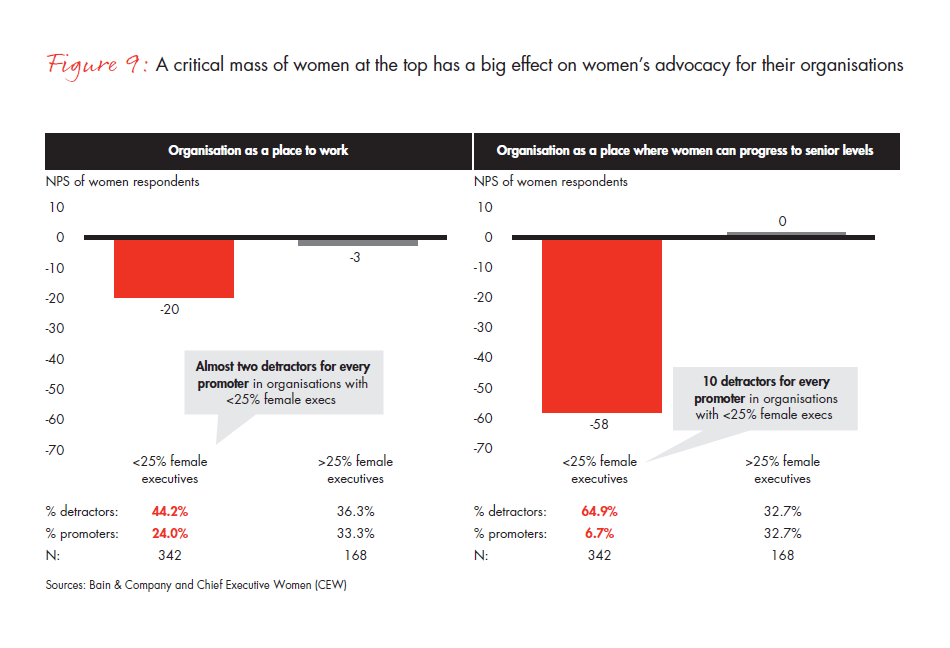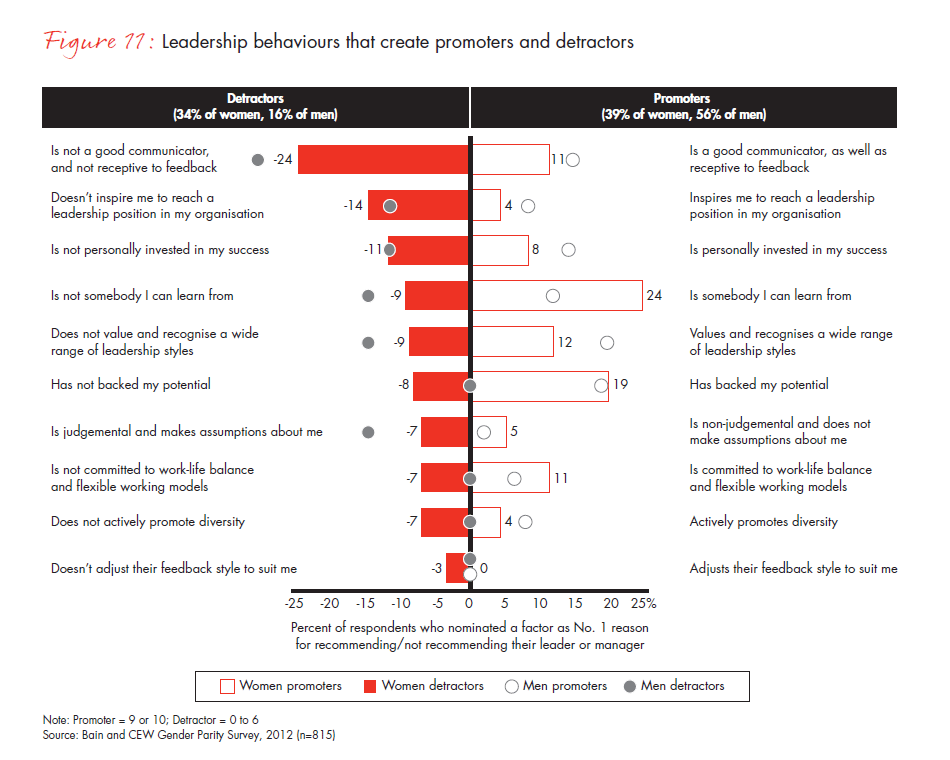Report

1. So many talented women, but so few at the top
Look at almost any Australian company’s executive management team, and the percentage of women is likely to be small. Even after decades of effort to change that reality, few business leaders—male or female—say they are satisfied with the progress that companies have made in moving women towards the top. The pace of change has been glacial, with no improvement in the last 10 years. Short of some bold actions, it will be many more decades before the representation of women in leadership comes anywhere close to achieving a critical mass, let alone equalling that of men.
Ironically, Australia’s pipeline of professional women has never been stronger. Since 1985, women have been graduating from university at higher rates than men; they have comprised approximately 60% of all graduates since 2000. These rates hold true for key disciplines, such as business and law, where females comprised 50% and 60%, respectively in 2011. These facts alone should place women among the most qualified candidates for entry-level positions and also create a sufficiently large pool of female candidates for progression through to the highest roles. An extremely positive and important reality is that these women are ambitious. Research by Bain & Company and Chief Executive Women (CEW) over the last three years has consistently found that women aspire to become senior business leaders at almost the same rate as men.
Given the abundance of educated women with ambition, it is in many ways surprising that only 10.1% of key executives in Australian Securities Exchange (ASX) 200 companies are female (see Figure 1), a statistic that has improved only marginally in the 10 years that Australia’s Equal Opportunity for Women in the Workplace Agency (EOWA) has been reporting it. Women are particularly underrepresented in executive line-management positions, the most significant roles that are often prerequisites for promotions to the very highest levels. With only 6% of these roles occupied by women, it is not unexpected that the number of female CEOs within the ASX200 currently stands at just seven.
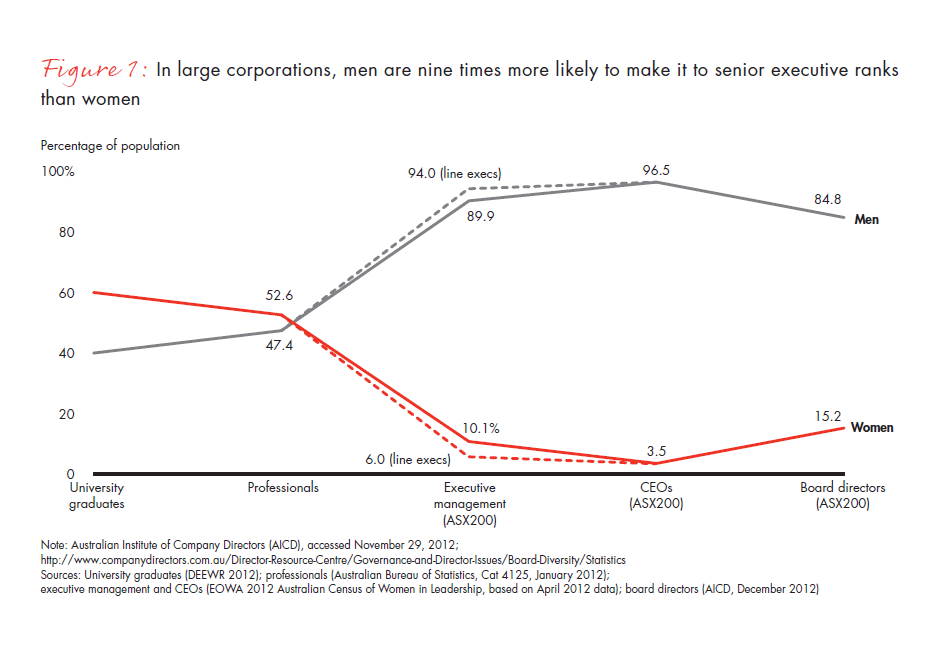
Why is it that women have been graduating from universities at greater rates than men for more than 25 years and yet a senior female executive still remains a rare sight? We recognise that many women (and an increasing but smaller number of men) make the legitimate choice to focus on raising a family, or choose an alternative career path, such as starting their own business. However, the statistics beg the question of whether or not Australian organisations are creating the right conditions for women to reach their full potential in their careers.
This gender imbalance creates both a business and moral imperative. Future efforts to right the imbalance will need to be significantly different from those of the past if we are to see any real breakthrough in the representation of women at senior levels. Based on the trends to date, it is evident that generational change alone will not be sufficient. It simply isn’t “just a matter of time.”
Good intentions, few results
The Australian business community overwhelmingly values the benefits of diversity. Almost 90% of both men and women surveyed by Bain and CEW are convinced of the benefits of gender parity; so much so that three-quarters of respondents believe that gender parity should be a critical strategic imperative for their own organisations.
Yet achieving gender parity has proved to be a difficult and complex issue to tackle and, unfortunately, good intentions have not translated into better perceptions of companies’ commitment to take action. Fewer than half of the women surveyed believe that their organisations have made gender parity a visible priority, and only one-third believe that their organisations have committed meaningful resources to implementing gender parity programs (see Figure 2). It is therefore hardly surprising that only 15% of women believe they have equal opportunity to be promoted to senior executive positions on the same timeline as men. Even when companies make a small amount of progress in improving women’s beliefs about their prospects, such gains appear to be difficult to sustain. For example, the uptick in women’s perceptions that organisations are making gender parity a priority and dedicating meaningful resources to diversity programs, which we reported in 2011, has mostly reverted to 2010 levels, according to this year’s research.
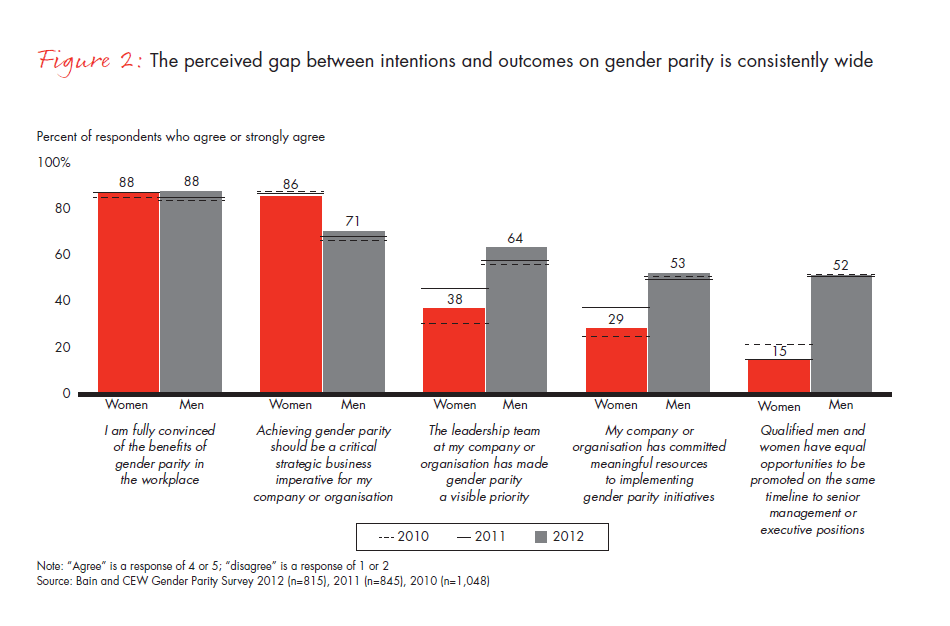
Underscoring the value that Australia places on gender parity, the ASX introduced new guidelines requiring companies to establish and report progress against gender diversity policies and targets, beginning in 2011. In theory, one would expect such disclosures to increase the actions taken by companies to move women into senior executive roles. So far, however, they reveal that there is a lot more work to be done. Close scrutiny of the first round of company reports shows that 4 in 10 companies still have no such policies or targets in place, suggesting that many companies have yet to address even the basics of the issue. And while it is commendable that 60% of organisations have already taken a range of actions to address gender diversity, what is clear is that policies and targets are not proving sufficient to increase the representation of women in senior executive roles.
Australian businesses care about gender diversity—that much is clear. But the results of past efforts to accomplish this are disappointing. On the ultimate measure of success—the appointment of women to senior roles—we are not making progress. For real change to occur, organisations must find new strategies to retain women, remove the barriers to their progress and start promoting them to senior leadership roles.
Understanding how to create the right environment
Last year’s survey revealed that the biggest barrier to female progression is that organisations do not value a diversity of leadership styles. Nearly 80% of women cited “differences in style” as the dominant inhibitor to their collective progress. This is a difficult cultural issue for which there is no easy fix, and it raises a complex question: How can corporate Australia create environments that embrace diversity?
Among other barriers cited in 2011, a notably smaller (and more junior) group of women—approximately 20%—attributed women’s lack of progression to the competing priorities of career and family. It is worth noting that the majority of men—about 60%—thought that competing priorities was the primary reason for the lack of progress for women. This disparity highlights the fact that there are some distinct differences between men’s and women’s perceptions on the inhibitors of progress.
This year, Bain and CEW set out to identify the organisational characteristics and individual leadership behaviours that create environments where diversity is valued and where women are able to reach their full potential. We also sought to understand how these characteristics change for women throughout their careers. For example, what career and life events define women’s experiences at different stages, and what are the real “moments of truth” that influence whether women will stay with or leave an organisation? Finally, we looked at the “bright spots”: what companies that create loyal female employees are doing to make a difference, and what we can learn from them.
We received responses from 815 members of the Australian business community, 74% of whom are female and 24%, male, with more than half of all respondents in senior management or board positions. This sample size allowed us to have confidence in the key findings of the survey, although we have been cautious in drawing comparisons between men and women due to the smaller and potentially non-representative sample of male respondents.
We used the Net Promoter® score (NPS®)—a measure of advocacy—to help us identify the main drivers of advocacy for both organisations and leaders. Previous research conducted by Bain shows that NPS is a reliable indicator of individual loyalty behaviour.
We asked respondents to rate the following questions on a scale of zero to 10:
1. How likely would you be to recommend your organisation as a place to work?
2. How likely would you be to recommend your organisation as a place for women to progress to senior levels?
3. How likely would you be to recommend your manager as someone to work for?
Depending on their scores, respondents were categorised as promoters, passives or detractors (see below “Net Promoter score explained” for more detail). The aggregate NPS for each question was calculated by subtracting the percentage of detractors from the percentage of promoters. The higher the NPS, the greater the advocacy levels for organisations or leaders.
To identify key improvement opportunities, respondents were then asked a series of follow-up questions, based on their scores. These questions sought to understand (1) what good organisations or leaders do to create promoters, (2) what organisations or leaders that create detractors are doing (or not doing) and (3) what it would take to turn passives into promoters.
Challenging start point: Low levels of advocacy among women
The starting point is challenging. For each of the advocacy questions, women’s NPS results indicate significantly lower levels of advocacy than men for both their organisations and their leaders. We found that women are half as likely as men to recommend their companies as a place to work, with only 27% of women respondents classified as promoters, compared with 53% of men. In absolute terms, women’s NPS is a net negative (negative 14) compared with a net positive (34) for men. To look at it another way, there are three women who are detractors of their organisations for every two who are promoters, suggesting that companies face some real challenges to creating environments that attract and retain women.
This weak level of advocacy drops further when women are asked how likely they would be to recommend their organisation as a place where women can progress to senior levels. Sadly, both genders are less enthusiastic on this front, but women’s NPS plummets to negative 38, compared with positive 9 for men.
What is most concerning about these results are the business implications that they carry with them. A growing body of research indicates that companies with a critical mass of senior female executives tend to financially outperform their peers. In addition, businesses are becoming increasingly aware of the real costs if they don’t improve diversity: costs in the form of higher employee turnover and the associated losses in productivity, as well as a lack of insight into critical markets, amongst others. Taken to its logical conclusion, a lack of diversity can have a negative effect on overall corporate results.
This real business risk is reinforced by the survey findings. Overall, fewer than half of the women surveyed see a long-term future with their current organisations, and this includes many who have powerful career aspirations. While almost 70% of women aim to become a senior business leader, a full third of those don’t aspire to such a role within their current organisations. In other words, women don’t lack ambition; what they do lack are workplaces where they can realise these ambitions. But why is it that so many women don’t see a path to senior leadership within their current organisations, and what are existing leaders doing or not doing to impede their ambitions?
Women’s NPS results send a strong message: If organisations are serious about addressing gender parity at the top, then they must first address what is driving low levels of advocacy among female employees at all levels. If they don’t, they will continue to struggle to build a diverse and committed workforce and retain talented women, and risk losing the business benefits that come with genuine diversity.
A fully engaged workforce is critical to higher productivity and profitability, says Partner Melanie Sanders in this short video. Getting more women into corporate leadership roles carries benefits not just for women and companies, but also for the Australian economy and society as a whole.
What to do now
For many business leaders, making progress on gender parity is not an easy task. Despite widespread recognition that something needs to be done, so far, the right solution has eluded most businesses. Existing efforts to bolster the ranks of female executives in Australian corporations are not translating into results.
So what can organisations do to turn this situation around and start ensuring that women attain senior executive roles? The 2012 Bain/CEW research has identified four significant insights that will help business leaders appoint more women into senior leadership positions.
1. The middle years matter. The path to the C-suite is generally made or broken at the junior and middle management levels, which is also when women report the lowest levels of advocacy for their organisations and when their confidence to become senior leaders begins to lag that of men.
2. Progress breeds more progress. Having a critical mass of women at the top translates into being able to attract and retain more women, meaning the gender imbalance starts to solve itself.
3. An inclusive culture is essential. Women’s different leadership styles can be a major barrier to progression in most organisations. A company that does not embrace a diversity of thinking is unlikely to create the right environment for women to flourish.
4. Every manager counts. While the tone at the top is important, employees experience culture in their daily interactions with those closest to them. Individual leaders must “walk the talk” every day on diversity for organisations to achieve sustained cultural change.
Each one of these differentiating factors is important in its own right, but the four are also inherently intertwined. Together, they help an organisation create a positive cycle where women feel optimistic about their workplace and progression opportunities, ultimately leading to more women executive appointments as well as higher levels of female advocacy throughout the organisation.
2. The middle years: A major inflection point
One key finding of this year’s research is that the middle years of women’s careers—generally when they attain junior and middle management levels—are the most critical career stage for companies to address. This stage is a crucial career-building time when ambitious professionals must gain a broad range of essential experiences, such as operational management roles and international assignments, if they are to be selected subsequently for more senior roles. Both women and men at this stage are striving for promotions; more than 50% of both genders in this group said they had been at a promotion point within the past three years.
Unfortunately, the research also shows that this is exactly when women’s advocacy for their organisations hits a low; a much sharper decline than the relatively slight dip that men also report at this stage. Compared with women at other career stages, women at the junior and middle management levels as well as those who are experienced but do not hold management positions, have the lowest level of advocacy for their organisations as a place to work, with NPS results of negative 21 and negative 26, respectively (see Figure 3). Advocacy levels among this group of women for their organisations as a place where women can progress to senior levels are even more negative; women at junior and middle management levels report an NPS of negative 55 and experienced women report an NPS of negative 58.
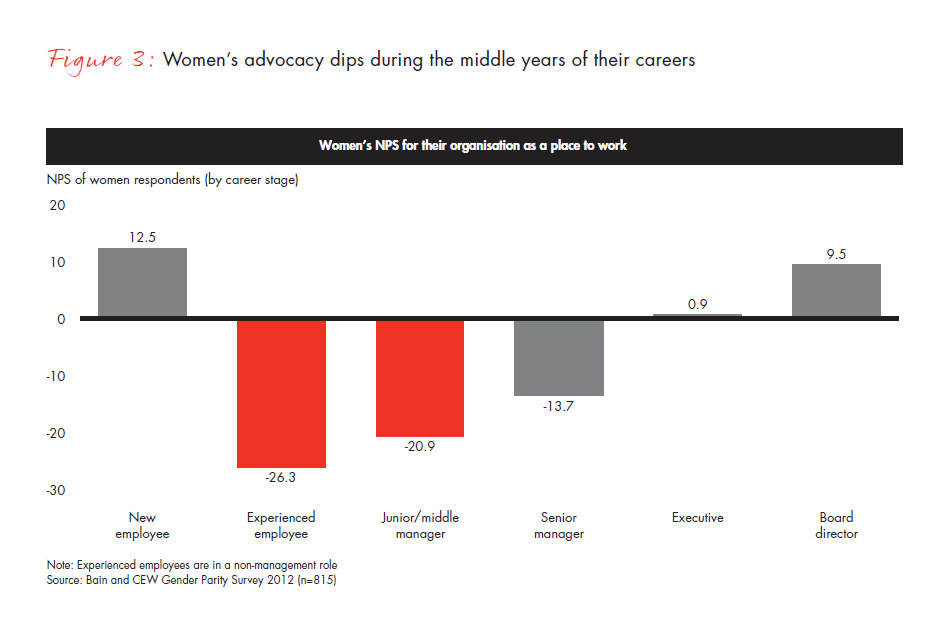
The middle years are when women start to realise that their often different style may be a barrier to promotion. At the junior and middle management level, 40% of women report that they have had a conversation about their style and fit with their organisation in the last three years, conversations that often carry some form of criticism for them (see Figure 4). “I have had discussions with my direct manager about needing to appear more confident, when I actually felt completely comfortable,” commented one female respondent. Other women observed that female traits are often not valued: “My female characteristics were seen as weaknesses,” and “Women are judged on male personality traits.” Women who do display more masculine leadership qualities are often judged far more harshly than their male peers. “Women get the feedback that they’re aggressive or abrasive in a very negative way,” said one respondent.
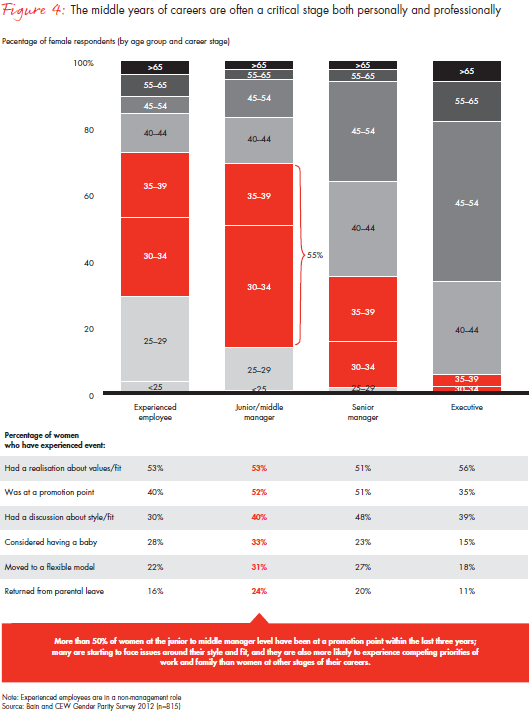
For many women, and increasing numbers of men, the middle years are also an intense time on the personal front. More than half (55%) of women at junior to middle management levels are between ages 30 and 39, when many professional women are starting families and begin to confront the challenges of integrating the demands of work and family. Our survey results show that women at this level are 50% more likely to have recently returned from parental leave and 30% more likely to have moved to a flexible working model than experienced or executive women.
Put questions about style together with the competing priorities of work and family, and it is understandable that women miss out on the surge in confidence that men seem to experience during this career phase. In fact, there is a confidence gap of nearly 20% between men and women in junior and middle management positions about their ability to become a senior business leader in their organisation (see Figure 5).
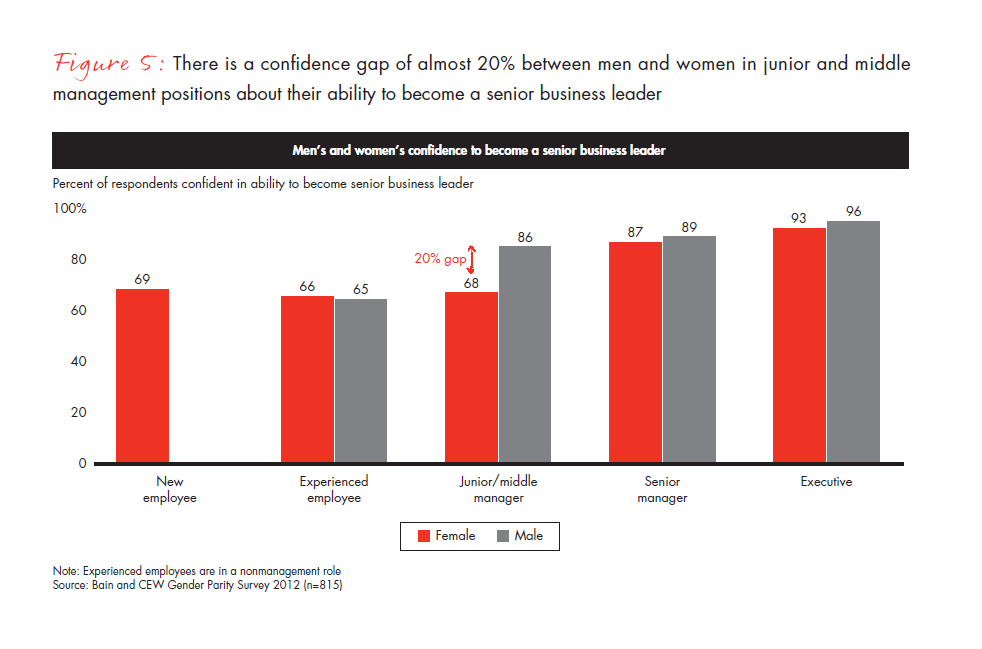
The combination of these factors tends to lead women in their middle years to question whether or not pushing past the barriers within their existing organisations is achievable. As they observe the lack of females promoted to senior roles within their organisations and calculate their own odds of being promoted to a senior role, many make the rational and informed decision to look for opportunities elsewhere, or to focus on their families. As one respondent in this group observed, “I have seen little evidence of women progressing to senior levels in my company.” Another respondent commented, “We have limited senior female role models in the firm to demonstrate that women can progress to senior levels.”
For others, the odds may appear stacked. “There is no transparency within the organisation regarding the availability of senior roles,” said one female respondent in this group. “Women need to put twice as much energy into self-promotion and gaining recognition, which is granted automatically to men. Then they have to prove themselves over and over,” wrote another. For those who stay, they may find that the policies their workplaces implement to retain them are what often become barriers to promotion. “As a part-time employee, my chances of promotion are limited,” said one woman.
To address these problems, organisations must ensure women can and do stay and progress through the crucial “middle years” of their careers to senior leadership roles. By focusing more attention earlier in women’s careers, companies will sharply increase their odds of developing a pool of women who can easily step into senior executive roles in the future.
3. How can organisations break the cycle?
What can organisations do to address women’s low levels of advocacy and their perceptions of a lack of progression opportunities, particularly during the middle years of their careers? The research suggests that it is not one single factor, but a combination of organisational characteristics and behaviours working together that either creates a positive or negative cycle for women. Efforts to increase the representation of women tend to be reinforcing and intensify over time; a fact that organisations can leverage to their advantage if they take the right steps.
What does a positive cycle look like? To start, women see other women attaining senior positions, signifying an authentically inclusive culture and providing essential role models (see Figure 6). Women at earlier stages in their career feel like they fit in, that their differences in style are appreciated and encouraged by their leaders. This makes women at all levels more confident in their own abilities and feel positive that there are pathways to reach their full potential—which, in turn, catalyses the next generation of women at the firm.
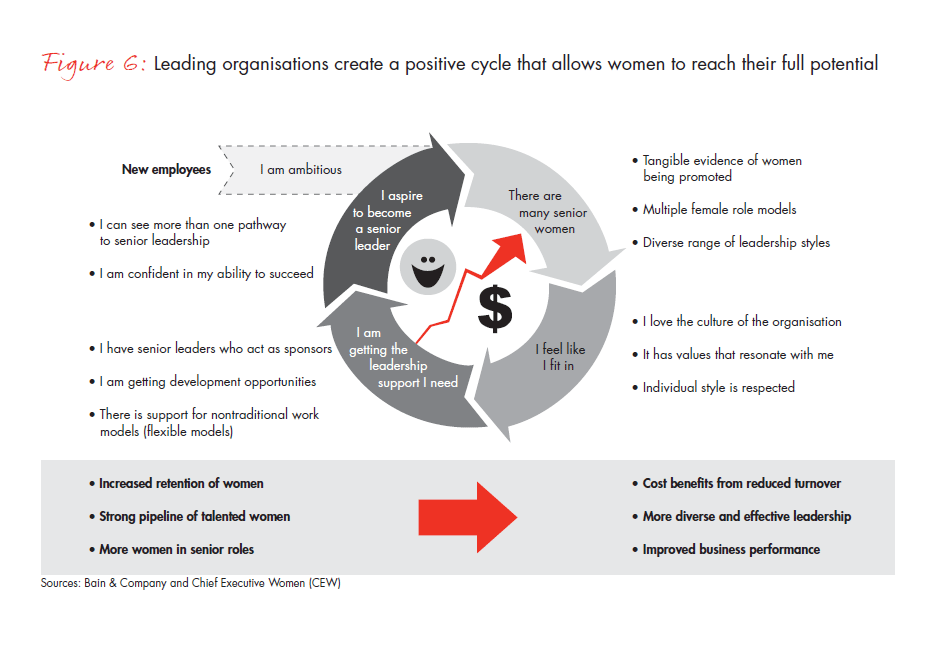
The absence of senior women, conversely, creates a credibility gap that undermines nearly everything else a company may try to do to improve diversity. As one female respondent explained, “The company talks a lot about gender parity, however, there are hardly any women in those senior positions and no clear career path for me or other colleagues.” After a lone female executive at one organisation resigned, another commented that “I and many view her as a symbol of lost hope for women reaching the very top of the house.”
When women don’t see other women being successful, they not only question their company’s commitment to gender parity, but they may also start to question whether they fit in with the culture and narrow range of demonstrated leadership styles (see Figure 7). In such environments, women may also perceive that they cannot achieve their full potential. As a result, the combination of all these factors means they don’t see a path to senior leadership that is achievable for them or even appealing to them. Ultimately, we see women forced to either readjust their career aspirations or leave their organisations.

So what can organisations do to start making progress? One thing that is abundantly clear is that an incremental approach is not enough. Those who are serious about change need to start taking tangible steps to demonstrate they are authentically committed to increasing gender diversity. The single most effective step is to build a critical mass of senior women leaders.
Appoint more women: Less talk, more action
Increasing female representation at the top is the one action that will have the greatest impact and improve female representation at all levels. When we asked what was the No. 1 reason for either recommending or not recommending their organisation as a place where women can progress to senior levels, both men and women said “a track record of promoting women” (18% of women detractors and 22% of women promoters), the “presence of diverse female role models in leadership positions” (17% of women detractors and 9% of women promoters) and “visible and committed leadership” (11% of women detractors and 24% of women promoters) (see Figure 8).
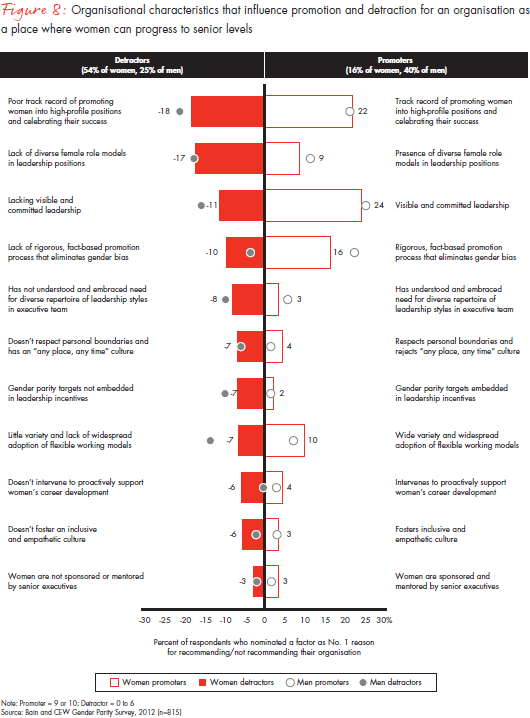
While the traditional tools for encouraging gender diversity—namely, good intentions, diversity policies and programs, and mentorship for women—are all necessary, they are simply not sufficient to drive real change in the near term. At the end of the day, it is the appointment and promotion of more women to executive roles that make the biggest differ-ence in how women perceive their own progression opportunities. Women want to see other women being successful.
This year’s research reinforces the positive business impact of increasing the number of women at the top of organisations. It shows that organisations with a critical mass of senior women have higher levels of advocacy amongst women—both as a place to work and as a place where women can progress to senior levels (see Figure 9). In fact, women working for organisations where more than a quarter of executives are female are 40% more likely (from 24% to 33% of promoters) than others to recommend their firms as a place to work, and overall NPS is higher by 17%. Even more importantly, women are five times more likely to recommend their organisation as a place where women can progress to senior levels when women are at a critical mass in leadership, comprising more than 25% of the leadership team.
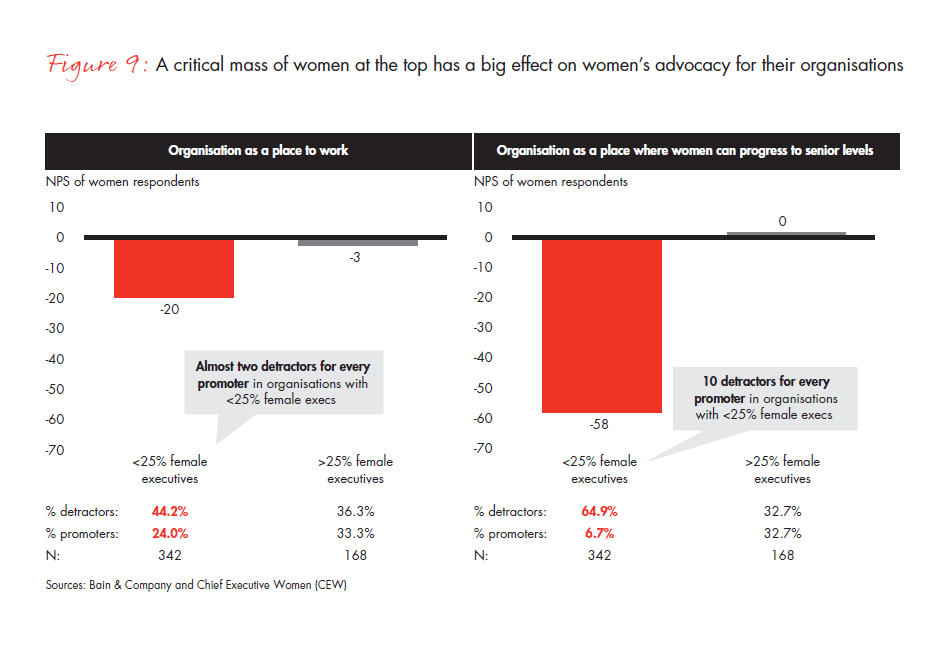
Having a female manager also makes a difference to women’s advocacy for their organisations. Women who work for female managers are 20% more likely to recommend their organisation as a place to work than those with male managers, and they are twice as likely to recommend their organisation as a place where women can progress to senior levels.
An inclusive culture is essential
Another reason that having a quorum of female leaders at the top appears to be so critical is that their presence transforms the culture from within, making it inherently more diverse and accepting. This is significant, as our research shows that a company’s culture and values are key factors influencing both men’s and women’s advocacy for their organisations. When we asked respondents to nominate the most important reason for recommending (or not recommending) their organisation as a place to work, the dominant answer for both men and women (26% of women detractors and 23% of women promoters) was “my company has a great culture, and its values resonate with me” (see Figure 10).
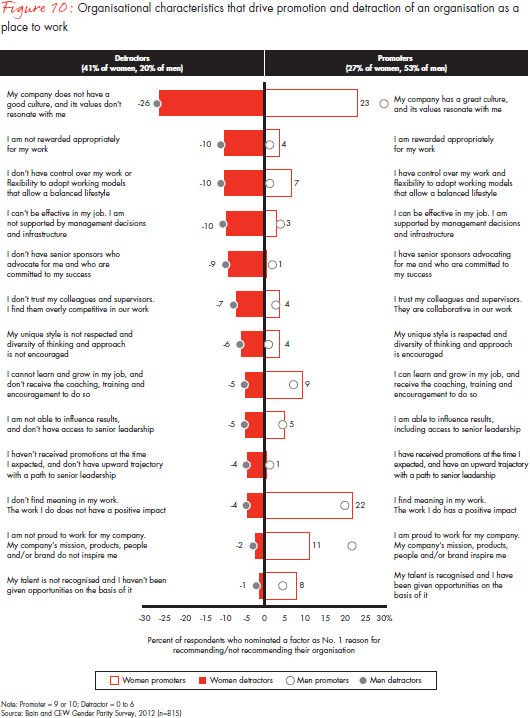
When done right, culture is a big driver of promotion. But what does culture really mean? For the small group of women who are promoters of their firms, culture is about a company “walking the talk where diversity is concerned,” being “collaborative” and “supportive and friendly.” Women also made the link between a positive culture and high performance: “strong commercial orientation coupled with meaningful values that are modelled by the senior executives,” noted one respondent.
Conversely, the larger group of women who cited culture as the driver for not recommending their organisations typically described it as having “fixed or closed ways of thinking,” being a “homogeneous blokey culture” or one where “female traits and values are not respected…it’s competitive, not collaborative.” Clearly, women’s perceptions of a broad term like “culture” have a strong connection to how well they feel their own contributions and styles are appreciated and valued.
This reinforces the findings of last year’s survey, in which nearly 80% of women reported differences in style as the main barrier to women’s progression. This is very closely related to culture, as differences in style are more appreciated in a diverse and inclusive culture. But culture is not just important to women. Men also cite culture as the top reason for either recommending or not recommending their organisation, highlighting the benefits to the entire workforce of creating a positive and inclusive environment.
We also found that the importance of an organisation’s culture changes as women progress in their careers. Women in senior executive positions, for example, are almost twice as likely as women in lower positions to cite culture as a reason for not recommending their firms as a place to work. This reflects the changing nature of work throughout the course of a career. As an executive gains responsibility, there is a sharper focus on leadership qualities and therefore more opportunities for clashes between company culture and individual styles to emerge.
Interestingly, when passive respondents were asked what it would take to turn them into promoters of their organisations, the No. 1 factor for women was “having senior sponsors who advocate for me and who are committed to my success.” Women say they see men getting sponsorship as a matter of course. “Men seem to get the tap on the shoulder to fill positions that were not advertised,” said one.
Women described good sponsorship as being different from mentoring. “It’s about going out to bat for someone, knowing them a bit more personally, being willing to put yourself on the line for these individuals,” said one. The impact of sponsors can be enormous, particularly in terms of proactively identifying and encouraging development and progression opportunities. “There were two men in very senior roles that pushed me to do things developmentally—like doing a master’s degree when I had two small children,” recalled one senior manager.
Every manager counts
Organisational culture is experienced in day-to-day interactions with colleagues and supervisors. Understandably, a person’s advocacy for their organisation is closely linked to their experiences with their leaders and managers, as well as the broader culture. Given our findings on women’s low advocacy levels for their organisations, it was no surprise to also find that women’s advocacy level for their leaders was significantly lower than men’s, with an NPS of positive 6 for women, compared with positive 40 for men.
When we asked people why they would recommend their leader or manager as someone to work for, the dominant reasons cited by women were “somebody I can learn from” (24% of women promoters), “has backed my potential” (19% of promoters) and “is a good communicator, as well as receptive to feedback” (11% of promoters) (see Figure 11). Women who are promoters of their managers typically described them as leaders who are “genuinely interested in developing staff,” who “trust us” and who “sell their teams to senior management.”

In contrast, women who would not recommend their leaders say their managers have poor communication skills and are not receptive to feedback (24% of women detractors cited this as the No. 1 reason), do not inspire them to reach a leadership position (14% of women detractors) and are not personally invested in their success (11% of women detractors). Typical comments included “not a great communicator, more interested in managing up than in engaging with the team” and “very intelligent but has trouble seeing situations from others’ perspectives.”
Not surprisingly, leaders or managers who facilitate work-life balance and flexible working models are more important for women at junior and middle management levels—a time when competing priorities of career and family are most significant. “Is committed to work-life balance and flexible working models” is the second most important reason for women in this group to recommend their leaders, after “is somebody I can learn from.” In fact, women in this group are almost twice as likely as women at other stages of their careers to cite support for flexibility as a reason for recommending their leaders.
Considering how profoundly managers influence work environments, it is essential that individual leaders and managers act as role models of inclusive behaviour and culture to ensure that everyone in the talent pipeline has an equal opportunity to reach their full potential.
4. What can organisations do to make tangible progress?
It is clear that improving the representation of women in the executive ranks of Australian organisations is not simply a matter of time. Our research shows that women’s advocacy for their organisations is far lower than men’s and is particularly low during the middle years of their careers. This has significant implications for businesses in terms of retaining and attracting talented women. So what can companies do to address these low levels of advocacy and create environments where women feel able to reach their full potential?
For real change to occur, organisations must create a positive cycle that ensures women at all levels feel optimistic that there is a pathway to reach their full potential—which, in turn, catalyses the next generation of women at the firm. This starts with demonstrating a tangible track record of promoting women, coupled with an inclusive culture and individual leaders “walking the talk.”
Women and men agree that appointing women into senior roles is the biggest differentiator in how women see their own progression opportunities. Women are five times more likely to be promoters of their organisation as a place where women can progress to senior levels when women are at critical mass in leadership, comprising more than 25% of the leadership team. This sends a strong message to business leaders that it’s time to appoint women to top roles to make a difference in Australian organisations.
We have identified four tangible actions organisations and leaders can take to increase appointments of women to leadership roles.
Sponsor and provide development opportunities for women. One of the biggest barriers for women in attaining senior leadership roles is acquiring all of the experiences a company deems most critical for promotion. Most frequently, organisations cite women’s lack of operational or line management experience as a disadvantage to their promotion prospects. Companies must therefore not only examine whether having such criteria is always necessary, but also ensure women at junior and middle management levels have the opportunity to develop and prove their readiness for bigger roles.
This is where sponsorship can make a difference by advocating for women to the broader organisation. Sponsors are important in encouraging women to take on critical career-building roles that will set them up for success when promotion opportunities arise. More importantly, senior sponsors play a key role in advocating for the appointment of individual women and challenging organisational norms around traditional paths to leadership.
Remove the barriers to appointing more women into leadership roles. Australian business leaders overwhelmingly agree that gender diversity creates benefits in the workplace. It is therefore imperative that people processes (including recruitment, selection and compensation) focus on building diverse talent pipelines, particularly for CEO and senior executive positions. That requires organisations to challenge the traditional assumptions about what good leadership looks like, and what career paths and experiences can ultimately lead to senior executive roles. It also requires that key people processes are not open to bias and that candidates for promotion are assessed against objective selection criteria. Setting minimum levels or targets for the number of women that form the candidate pool considered by the board or executive for succession can create an “acid test” for a gender neutral process.
Focus on the middle of the female talent pipeline. The middle years matter—this is a crucial career-building time for individuals aspiring to senior leadership. Yet this is also when women are most likely to experience significant barriers to progression, and hence it is a career stage that is highly vulnerable to “leaking” female talent. Therefore, monitoring the talent pipeline level in middle management and diagnosing key retention risks is important for ensuring that the strong pool of female graduates translates to greater representation of women at senior levels. Choosing the right metrics to monitor is also important. Companies should not only measure the representation of women at each level, top to bottom, but also promotion rates and promotion time frames for women compared with those for men.
In addition, promoting flexible work practices is vitally important for women’s advocacy at this stage of their career. Women in the middle years are almost twice as likely to cite management support for flexibility as a reason for recommending their leader or manager than women at other career stages. Therefore, it is critical that organisations ensure flexible working models are available when they will make the biggest difference. Women need to see these models working and feel there is genuine commitment from their management to making it work.
Make every manager count to build an inclusive culture. Individual leadership undoubtedly makes a huge difference to creating inclusive cultures where women feel able to achieve their full potential. And the formula for good leadership is clear—it includes being someone others can learn from, backing the potential of team members and being a strong communicator and listener. Upward feedback from team members can be a powerful source of insight about how managers are performing on these dimensions, particularly if the feedback can be disaggregated by gender. Using this valuable data to show leaders how they need to adapt their leadership behaviours will inevitably help create environments where both women and men can be successful.
Achieving gender parity in business is not a simple task, but it’s clear that it is a worthwhile one. Getting more women into corporate leadership roles carries benefits not just for women and companies, but also for the Australian economy and society as a whole. The good news is that it can be done: We have already seen individual businesses rapidly change the gender balance in their executive ranks. If other companies employ similar strategies and attitudes, a widespread transformation across the Australian business community will be both achievable and imminent.
Melanie Sanders is a partner with Bain & Company. She leads Bain’s Asia-Pacific Customer Strategy and Marketing practice and the Asia-Pacific Women at Bain program. David Zehner is the managing partner of Bain & Company Australia. Dr. Jenny Fagg is a CEW member and the former Chief Executive Officer of ANZ National Bank Limited, New Zealand’s largest bank. Meredith Hellicar is a member of the CEW committee and principal of Merryck & Company, formerly having a range of CEO roles and the chairmanship of Australian public and private companies, international boards and committees.
The Net Promoter® score (NPS®) groups respondents into three categories: promoters, passives and detractors.
- Promoters (score of 9 or 10): People who feel that their lives have been enriched by their relationship with their organisation or leader. They behave like loyal employees, typically staying longer and talking the organisation up to their friends and colleagues.
- Passives (score of 7 or 8): People who are fairly satisfied employees, but not loyal ones. They rarely talk their company up, and when they do, it’s likely to be qualified and unenthusiastic. If a better offer comes along, they are likely to defect.
- Detractors (score of 0 to 6): People who feel their lives have been diminished by their association with their organisation or leader. They are dissatisfied and even dismayed by how they are treated. They frequently speak negatively about their organisation and are likely to leave as soon as they find something better.
NPS is calculated by subtracting the percentage of detractors from the percentage of promoters.
The Woolworths story
One organisation that has broken the cycle and challenged some traditional business practices is Woolworths. In the past eight years, Woolworths has increased female representation in its senior executive team by nearly 70%—from 16% to 27% of its senior executives.
The “ah-ha” moment for Woolworths came in 2004, when the company was confronted with the fact that it did not have enough managers on staff to meet its growth plans. Getting more women into management positions became a business imperative—and Woolworths moved fast.
“We looked at the resourcing we needed for our upcoming growth…and we needed the best talent…but although 55% of our people were women, only 16% of executives were. We needed the best talent we could get…so that is why we wanted to build a talent pipeline for women, as well as men.”
Kim Schmidt, former director of human resources (2007–2012)
After some encouraging early results, Woolworths realised that making further progress would require leaders to question traditional business assumptions and uncover unconscious biases that were at play. The most significant breakthrough came in 2007, when then-CEO Michael Luscombe appointed Julie Coates (former head of HR) to be the logistics director and then to lead Big W. That was followed by the appointment of Debra Singh to be the general manager of Dick Smith Electronics.
These appointments were significant for two reasons. First, they challenged the traditional path to leadership, since the two women had not rotated through the standard combination of prerequisites for senior executive line management roles. Second, they sent a strong signal to the organisation that the new leadership was gender neutral.
“Michael led the way when he appointed people that had not followed the accepted career path of leaders…He broke down this ingrained promotion practice, and when he did that, there were many other opportunities that followed.”
Kim Schmidt, former director of human resources (2007–2012)
Many more appointments followed. This has led to a shift in perceptions about the path to leadership, and women have responded positively to the new role models.
“I was surprised when some women here said to me, ‘It’s great to see a female doing that role.’ It is really interesting to hear females make these comments and say, ‘I’d like to talk to you about how I can advance myself.’”
Jennifer Brice, group financial controller (2009–present)
That focus on gender diversity continues under current CEO Grant O’Brien, who has seen firsthand how talented women leaders can rise to the challenge and why diversity in management is important. “These leaders give permission to other Woolworths’s employees to act differently. They create an environment where it is more acceptable to challenge the way things are done,” he noted in a recent report.

